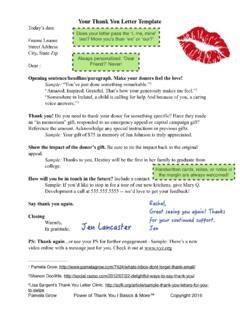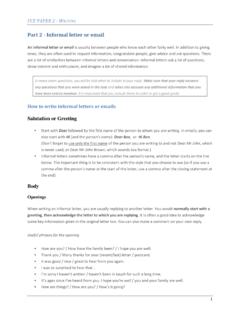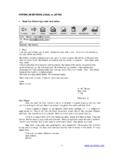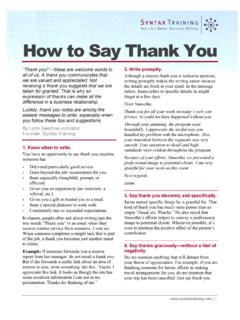Transcription of ANATOMY OF A NONPROFIT THANK YOU LETTER
1 ANATOMY OF A NONPROFIT THANK YOU LETTER That Inspires Future Passionate Gifts A Checklist of Key Elements + Samples Includes a Link to a Free Gift + Free Quick Consult Claire Axelrad, , CFRE Copyright 2013 All Rights Reserved 2 A first-time gift is often made as a test. It s a spur-of-the-moment or a favor to a or a let s see what they do with this/how they treat me sort of transaction. A second gift is often made from habit. It s an I did it before, so I must ve been right type of action. No real decision-making involved.
2 Giving can be a rut. A semi-passive endeavor. But creative, personal, awesome THANK you letters can get your donors out of their ruts and move them towards active, thoughtful, and even passionate, giving. Let s begin with reminding yourself of the purposes of your THANK you LETTER . To promptly let the donor know the gift was received. To show how deeply appreciative you are. To be clear about what the gift will accomplish. To demonstrate that you re an organization that pays attention to detail (include in the LETTER any personal information, such as the fact the donor would like the gift (1) earmarked for a particular purpose; (2) kept anonymous; (3) dedicated to someone s memory or honor, etc.)
3 To warmly welcome the donor into your family a group of people with shared values. To make the donor feel a part of something larger than themselves. To validate the donor; let them know they made a great decision to give to you. To reconnect the donor with your mission, vision and values. To show the donor some love it s not just about their money; let them know other ways they can be involved with you. To help the donor learn a little bit more about you. THANK you is the beginning of the donor relationship, not the end.
4 The gift is simply a business transaction. If you simply enter the gift into your database and generate an automated receipt, you re not doing anything to transform this one-time action into an ongoing relationship. If you simply spew forth a one-size-fits-all LETTER , you re not doing anything to build a personal meaningful relationship. Effective THANK you letters are thoughtfully designed to create a lasting bond that will bring in funds year after year. 3 THANK you letters are not a place to talk about your needs or reiterate mind-numbing statistics about the numbers of people, places or things that still need help.
5 These letters only make the donor feel hopeless as if what they did was too little to ever make a dent in the problem. Worse yet, they often are perceived as second appeals for money. THANK you letters are a place to tell inspiring stories. Particularly the story of one person, child, or animal whose life was made better through the donor's help. A whitepaper from Burk s Cygnus Applied Research notes that the 1997 National Survey of Giving, Volunteering and Participating study found that up to five out of every ten donors stop giving or give less because they feel, in part, that their giving isn t Research by Adrian Sargeant reveals that if you can increase donor retention by just 10% you can increase the lifetime value of these supporters to your organization by 200%.
6 That s whopping! let s take a look at some simple things you can do to capture your donor s attention and captivate their emotions. THE SWEET 16 KEY ELEMENTS OF EFFECTIVE THANK YOU LETTERS There are certain elements every THANK you LETTER must include. Think about the best ones you ve received when you ve given a birthday or wedding present. Chances are the most memorable ones were heartfelt, emotional, tangible and original. They made you feel glad you gave the perfect gift. Good THANK you letters to donors are no different.
7 I ve heard them described as a smile in an envelope. Basics are: 1. Date This seems obvious, but don t forget it. In other words, even if you have a pile of pre-fab letters sitting around (which I don t advocate!) make sure you add in the date. I m also hoping that the fact you re including the date will make you embarrassed if you get the LETTER out too late. 2. Personal salutation 1 Penelope Burk is author of Donor-Centered Fundraising. It s a must-read for any fundraiser who aspires to be worth their salt.
8 I completely changed the way I did fundraising after hearing her present her research and reading her book. 4 No Dear Friend please. And no Dear Mr. Donor either. Wasn t the donor s name on the check they sent or the credit card they used? Use the donor s first name unless they (1) are clergy; (2) are a political figure, or (3) have made it clear they prefer a formal salutation. Again, don t argue with me. Informal is the way of the world in the 21st century. And use a comma after the name rather than a colon. The latter is for formal business letters; not for warm THANK you letters.
9 3. Catchy opening line "On behalf of ___, thanks for your gift. This makes me cringe! If you use this tired, boring opener chances are your donor will read no further. They ll file or toss the LETTER . You ve lost your chance to inspire and bond. The thanker thanks. Not on behalf of someone else. Here are some much better examples: You remembered, because they couldn t. (Alzheimer s charity) Children will sleep safely tonight, because you care. (Women and children s shelter) Hunger shouldn t be an option; thanks to you it won t be.
10 (Food bank) This year s lunch program is safe. Because of you. (Senior center) 4. Feedback on how donation will be used Per research by Penelope Burk in Donor-Centered Fundraising, keeping donors informed about how their money was used is one of the most important ways to ensure future gifts. One of the most effective ways to communicate this information is to share a good success story. Stories are more memorable and more powerful than a recitation of a bunch of facts and figures (and when you do that the LETTER begins to be perceived as another solicitation).











